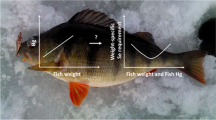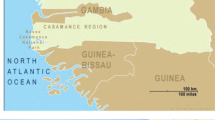Abstract
Interactions between mercury and selenium accumulation and subcellular binding inAsterias rubens (L.), collected in 1987 from Lille Bælt at Middelfart, Funen, Denmark, were investigated in laboratory experiments. Sea stars exposed to 10µg Hg l−1 for 30 d accumulated mercury in body wall, tube feet and stomach linearly with time at 1.2, 1.2 and 0.5µg Hg g−1 dry wt d−1, respectively. Mercury was accumulated in pyloric caeca and coelomic fluid initially at 1.4µg Hg g−1 dry wt d−1 and 9.4 ng Hg ml−1 d−1, respectively; after 10 d uptake rates decreased. Sea stars exposed to 75µg Se-SeO - -3 l−1 accumulated selenium linearly with time over 30 d in the stomach, pyloric caeca, tube feet and body wall at 2.0, 1.2, 1.2 and 0.6µg Se g−1 dry wt d−1. Sea stars exposed to 75µg Se-SeO - -4 l−1 maintained selenium levels in the coelomic fluid at 75µg Se l−1 over 30 d. Exposure to selenate did not alter the selenium concentrations in the tissues. Sea stars exposed concurrently to 75µg Se-SeO - -3 and 10µg Hg l−1 accumulated more mercury and selenium in tube feet and body wall than did sea stars exposed to the two elements alone. In pyloric caeca and stomach concurrent exposure reduced accumulation of both elements. Mercury was bound predominantly in the insoluble fraction of the tissues, and soluble mercury was bound in proteins of high (> 70 kilodaltons) or very low (< 6000 daltons) molecular weight. Ca. half of the selenium recovered was bound in the insoluble fraction, and soluble selenium was bound in proteins of high (> 70 kilodaltons) or very low (< 6000 daltons) molecular weight. Interaction between the two elements was exerted predominantly in the insoluble fraction of the tissues.
Similar content being viewed by others
Literature cited
Ahsanullah, M., Brand, G. W. (1985). Effect of selenite and seleniferous fly-ash leachate on growth and viability of the marine amphipodAllorchestes compressa. Mar. Biol. 89: 245–248
Apte, S. C., Howard, A. G., Morris, R. J., McCartney, M. J. (1986). Arsenic, antimony and selenium speciation during a spring phytoplankton bloom in a closed experimental ecosystem. Mar. Chem. 20: 119–130
Armstrong, F. A. J., Uthe, F. J. (1971). Semi-automated determination of mercury in animal tissue. Atom. Absorp. Newsl. 10: 101–103
Besten, P. J. den, Herwig, H. J., Zandee, D. I., Voogt, P. A. (1989). Cadmium accumulation and metallothionein-like proteins in the sea starAsterias rubens. Mar. envirl Res. 28: 163–166
Bienvenue, E., Boudou, A., Desmazès, J. P., Gavach, C., Sandeaux, R., Seta, P. (1984). Transport of mercury compounds across bimolecular lipid membranes: effect of lipid composition, pH and chloride concentration. Chem. biol. Interactions 48: 91–101
Binyon, J. (1978). Some observations upon the chemical composition of the starfishAsterias rubens L., with particular reference to strontium uptake. J. mar. biol. Ass. U.K. 58: 441–449
Bjerregaard, P. (1988). Effect of selenium on cadmium uptake in selected, benthic invertebrates. Mar. Ecol. Prog. Ser. 48: 17–28
Bjerregaard, P. (1990). Influence of physiological condition on cadmium transport from haemolymph to hepatopancreas inCarcinus maenas. Mar. Biol. 105: 17–28
Broertjes, J. J. S., Jens, J. N., Oudheusden, D. van, Bruin, M. de, Voogt, P. A. (1982). Demonstration of nutrient flow in the starfishAsterias rubens (L.) with125I labelled proteins. Neth. J. Zool. 32: 472–478
Broertjes, J. J. S., Posthuma, G., Beijnink, F. B., Voogt, P. A. (1980). The admission of nutrients from the digestive system into the heamal channels in the sea-starAsterias rubens (L.). J. mar. biol. Ass. U.K. 60: 883–890
Chen, R. W., Whanger, P. D., Fang, S. C. (1974). Diversion of mercury binding in rat tissues by selenium: a possible mechanism of protection. Pharmac. Res. Communs 6: 571–579
Cutter, G. A., Bruland, K. W. (1984). The marine biogeochemistry of selenium: a re-evaluation. Limnol. Oceanogr. 29: 1179–1192
Cutter, G. A., Church, T. M. (1986). Selenium in western atlantic precipitation. Nature, Lond. 322: 720–722
Davis, I. M., Russel, R. (1988). The influence of dissolved selenium compounds on the accumulation of inorganic and methylated mercury compounds from solution by the musselMytilus edulis and the plaicePleuronectes platessa. Sci. total Envir. 68: 197–205
Egaas, E., Julshamn, K. (1978). A method for the determination of selenium and mercury in fish products using the same digestion procedure. Atom. Absorp. Newsl. 17: 135–138
Fowler, S. W. (1990). Critical review of selected heavy metals and chlorinated hydrocarbon concentrations in the marine environment. Mar. envirl Res. 29: 1–64
Fowler, S. W., Benayoun, G. (1976). Influence of environmental factors on selenium flux in two marine invertebrates. Mar. Biol. 37: 59–68
Gutknecht, J. (1981). Inorganic mercury (Hg2+) transport through lipid bilayer membranes. J. Membrane Biol. 61: 61–66
Kester, D. R. (1986). Chemical species in marine and eustuarine systems. In: Bernhard, M., Brinckman, F. E., Sadler, P. J. (eds.) The importance of chemical “speciation” in environmental processes. Dahlem Konferenzen, p. 275–299
Koeman, J. H., Peeters, W. H. M., Koudstaal-Hol, C. H. M., Tjioe, P. S., Goeij, J. J. M. de (1973). Mercury-selenium correlations in marine mammals. Nature, Lond. 245: 385–386
Koeman, J. H., Ven, W. S. M. van de, Goeij, J. J. M. de, Tjioe, P. S., Haaften, J. L. van (1975). Mercury and selenium in marine mammals and birds. Sci. total Envir. 3: 279–287
Komsta-Szumska, E., Chmielnicka, J. (1977). Binding of mercury and selenium in subcellular fractions of rat liver and kidneys following separate and joint administration. Arch. Toxic. 38: 217–228
Komsta-Szumska, E., Chmielnicka, J., Piotrowski, J. K. (1976). The influence of selenium on binding of inorganic mercury by metallothionein in the kidney and liver of the rat. Biochem. Pharmac. 25: 2539
Lucu, C., Skreblin, M. (1981). Evidence on the interaction of mercury and selenium in the shrimpPalaemon elegans. Mar. envirl Res. 5: 265–274
Lunde, G. (1973). The presence of lipid-soluble compounds in marine oils. Biochim. biophys. Acta 304: 76–80
Mackay, N. J., Kazacos, M. N., Williams, R. J., Leedow, M. I. (1975). Selenium and heavy metals in black marlin. Mar. Pollut. Bull. 6: 57–61
Magos, L., Clarkson, T. W., Hudson, A. R. (1984). Differences in the effects of selenite and biological selenium on the chemical form and distribution of mercury after the simultaneous administration of HgCl2 and selenium to rats. J. Pharmac. exp. Ther. 228: 478–483
Magos, L., Webb, M. (1980). The interactions of selenium with cadmium and mercury. CRC critical Rev. Toxic. 8: 1–42
Martoja, R., Viale, D. (1977). Accumulation de granules de sélénium mercurique dans le foie d'odontocètes (Mammifères, cétacés): Un mécanisme possible de détoxication du méthylmercure par le sélénium. C. r. hebd. Séanc. Acad. Sci., Paris 285: 109–112
Measures, C. I., Burton, J. D. (1980). The vertical distribution and oxidation states of dissolved selenium in the northeast Atlantic Ocean and their relationship to biological processes. Earth planet. Sci. Lett. 46: 385–396
Measures, C. I. McDuff, R. E., Edmond, J. M. (1980). Selenium redox chemistry at Geosecs I re-occupation. Earth planet. Sci. Lett. 49: 102–108
Norheim, G. (1987). Levels and interactions of heavy metals in sea birds from Svalbard and the Antarctic. Envir. Pollut. 47: 83–94
Olafson, R. W., Kearns, A., Sim, R. G. (1979). Heavy metal induction of metallothionein synthesis in the hepatopancreas of the crabScylla serrata. Comp. Biochem. Physiol. 62B: 417–424
Parizek, J., Ostadalova, I. (1967). The protective effect of small amounts of selenite in sublimate intoxication. Experientia 23: 142–143
Patel, B., Chandy, J. P., Patel, S. (1988). Do selenium and glutathione inhibit the toxic effects of mercury in marine lamellibranchs? Sci. total Environ. 76: 147–165
Pelletier, E. (1985). Mercury-Selenium interactions in aquatic organisms: a review. Mar. envirol. Res. 18: 111–132
Pelletier, E. (1986). Modification de la bioaccumulation du sélénium chezMytilus edulis en présence du mercure organique et inorganique. Can. J. Fish. aquat. Sciences 43: 203–210
Pelletier, E., Larocque, R. (1987). Bioaccumulation of mercury in starfish from contaminated mussels. Mar. Pollut. Bull. 18: 482–485
Phillips, D. H. J. (1987). Toxic contaminants in the San Francisco Bay-Delta and their possible biological effects. Technical Report of the Aquatic Habitat Institute, 1301 South 46th St, Richmond, California 94804, USA
Plas, A. J. van der, Jangoux, M., Voogt, P. A. (1984). A light and electron microscopial study of pyloric caeca ofAsterias rubens (Echinodermata: Asteroidea). Neth. J. Zool. 34: 144–158
Roesijadi, G., Hall, R. E. (1981). Characterization of mercury-binding proteins from the gills of marine mussels exposed to mercury. Comp. Biochem. Physiol. 70C: 59–64
Tusek-Znidaric, Skreblin, M., Pavicic, J., Kregar, I., Stegnar, P. (1986). Mercury binding proteins of the gills and digestive gland ofMytilis galloprovincialis. F.A.O. Fish. Rep. 334: 149–154
Wadge, A., Hutton, M. (1987). The leachability and chemical speciation of selected trace elements in fly ash from coal combustion and refuse incineration. Envir. Pollut. 48: 85–99
Wrench, J. J. (1978). Selenium metabolism in the marine phytoplanktersTetraselmis tetrathele andDunaliella minuta. Mar. Biol. 49: 231–236
Wrench, J. J. (1979). Uptake and metabolism of selenium by oysters. Mar. Sci. Communs 5: 47–59
Author information
Authors and Affiliations
Additional information
Communicated by T. Fenchel, Helsingør
Rights and permissions
About this article
Cite this article
Sørensen, M., Bjerregaard, P. Interactive accumulation of mercury and selenium in the sea starAsterias rubens . Mar. Biol. 108, 269–276 (1991). https://doi.org/10.1007/BF01344342
Accepted:
Issue Date:
DOI: https://doi.org/10.1007/BF01344342




